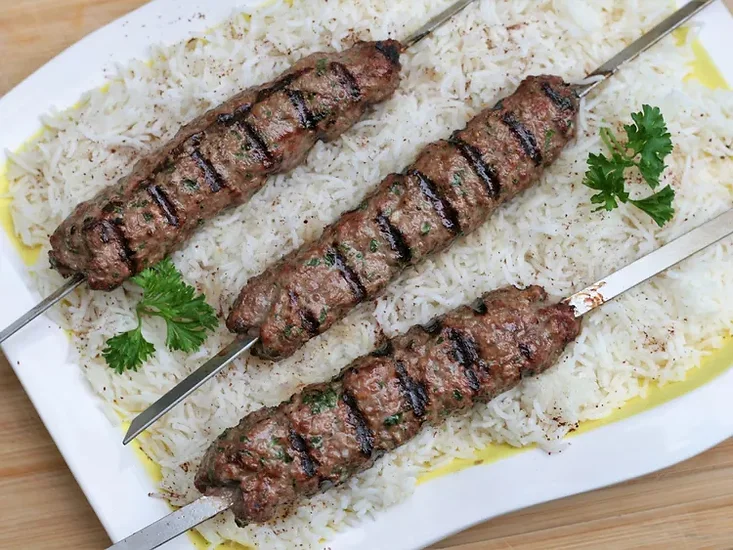A Culinary Journey with Lebanese Kafta Kabobs, Lebanese Makdous, and Other Lebanese Side Dishes

Lebanese cuisine is a true reflection of the country's rich history, diverse culture, and the Mediterranean's culinary influences. If you’re a food lover or someone who enjoys exploring new flavors, the world of Lebanese side dishes like Lebanese Kafta Kabobs and Lebanese Makdous is bound to excite your taste buds.
What are Lebanese Kafta Kabobs?
Lebanese Kafta Kabobs are a popular grilled dish that’s not just delicious but also very easy to make. Kafta is typically made from ground meat, usually a mix of lamb and beef, flavored with herbs like parsley, onion, and a blend of Middle Eastern spices such as cumin, cinnamon, and allspice.
Once the meat mixture is prepared, it's molded onto skewers and grilled to perfection. The result is juicy, flavorful kabobs with a slight char that’s irresistible. These kabobs are usually served alongside fresh salads, hummus, or even Lebanese side dishes like tabbouleh and baba ghanoush.
How to Make Kafta Kabobs at Home
To make Lebanese Kafta Kabobs at home, you'll need:
- Ground beef or lamb (or a mix)
- Finely chopped parsley
- Minced onion
- Garlic (optional but recommended for extra flavor)
- Spices: cumin, allspice, cinnamon, salt, and pepper
Mix everything together, shape the mixture into oblong patties or mold it onto skewers, and grill them on high heat. Serve with pita bread, hummus, or pickled vegetables.
Kafta Kabobs are versatile and can be eaten as part of a mezze (small plates) or as the main protein in a more filling meal.
Exploring Lebanese Makdous
Lebanese Makdous is another delightful treat from the Lebanese kitchen. This dish features baby eggplants stuffed with walnuts, red pepper, garlic, and occasionally chili for some heat, then preserved in olive oil. The eggplants are first boiled and then left to dry slightly before they are stuffed, packed tightly in jars, and submerged in oil to ferment. The fermentation process gives Makdous its unique tangy and savory flavor, making it an essential part of Lebanese breakfasts or mezze.
Makdous is usually served cold and pairs excellently with Lebanese side dishes like labneh (a strained yogurt dip) and warm pita bread. Its slightly spicy, tangy, and nutty flavor makes it a standout item on any table.
How to Make Lebanese Makdous
The process of making Lebanese Makdous might seem intricate, but it's worth the effort:
- Baby eggplants
- Walnuts (finely chopped)
- Red peppers
- Garlic
- Olive oil
First, the baby eggplants are boiled and left to dry for a day. Then, they are carefully slit and stuffed with a mixture of finely chopped walnuts, garlic, and red pepper. After stuffing, the eggplants are stored in a jar filled with olive oil, allowing the flavors to blend over a few days or weeks. The longer they sit, the richer the taste becomes.
The Rich Variety of Lebanese Side Dishes
The Lebanese side dishes category is full of fresh, flavorful, and healthy options. From dips to salads, Lebanese cuisine has side dishes that not only complement main dishes but can stand alone as well. Let’s explore some of the most popular options:
- Tabbouleh: A refreshing salad made with parsley, bulgur, tomatoes, mint, and a zesty lemon dressing.
- Fattoush: A bread salad made from crispy fried pita and mixed greens, topped with a sumac dressing for a tangy finish.
- Hummus: The classic chickpea dip, blended with tahini, lemon, and garlic, and drizzled with olive oil.
- Baba Ghanoush: A smoky, creamy eggplant dip that’s similar to hummus but with a distinct roasted flavor.
- Lebanese Pickles: Known as 'Kabis,' these pickled vegetables are crunchy, tangy, and provide a great contrast to the richness of meats like Lebanese Kafta Kabobs.
Each of these Lebanese side dishes brings its unique flavor and texture to the table, making any meal an exciting and flavorful journey.
FAQs
Q1: What makes Lebanese Kafta Kabobs different from other kabobs?
Lebanese Kafta Kabobs are unique because of the spice blend used, particularly the inclusion of cinnamon and allspice, which gives them a distinctive Middle Eastern flavor profile. Additionally, they often include both beef and lamb, making them juicier and more flavorful.
Q2: How long does it take to make Lebanese Makdous?
While the initial preparation of Lebanese Makdous (boiling the eggplants and stuffing them) can take a couple of hours, the real magic happens during the fermentation process, which can take anywhere from a few days to a couple of weeks.
Q3: What are some traditional pairings with Lebanese side dishes?
Lebanese side dishes like tabbouleh, hummus, and baba ghanoush are often paired with grilled meats, pita bread, and pickles. They also go well with dishes like falafel, shawarma, and kibbeh.
Q4: Can I store Lebanese Kafta Kabobs and Makdous for later?
Yes! Lebanese Kafta Kabobs can be stored in the fridge for up to 3 days, or you can freeze them for a longer period. Lebanese Makdous can last for several months when stored properly in oil.
Conclusion
Lebanese cuisine is a wonderful blend of flavors, textures, and aromas that anyone can enjoy. Whether you’re indulging in the succulent Lebanese Kafta Kabobs, savoring the tangy richness of Lebanese Makdous, or enjoying the refreshing variety of Lebanese side dishes, there’s something for everyone to love. The versatility and simplicity of these dishes make them perfect for home cooks looking to explore the vibrant world of Middle Eastern cuisine.
- Industry
- Art
- Causes
- Crafts
- Dance
- Drinks
- Film
- Fitness
- Food
- Giochi
- Gardening
- Health
- Home
- Literature
- Music
- Networking
- Altre informazioni
- Party
- Religion
- Shopping
- Sports
- Theater
- Wellness
- News


